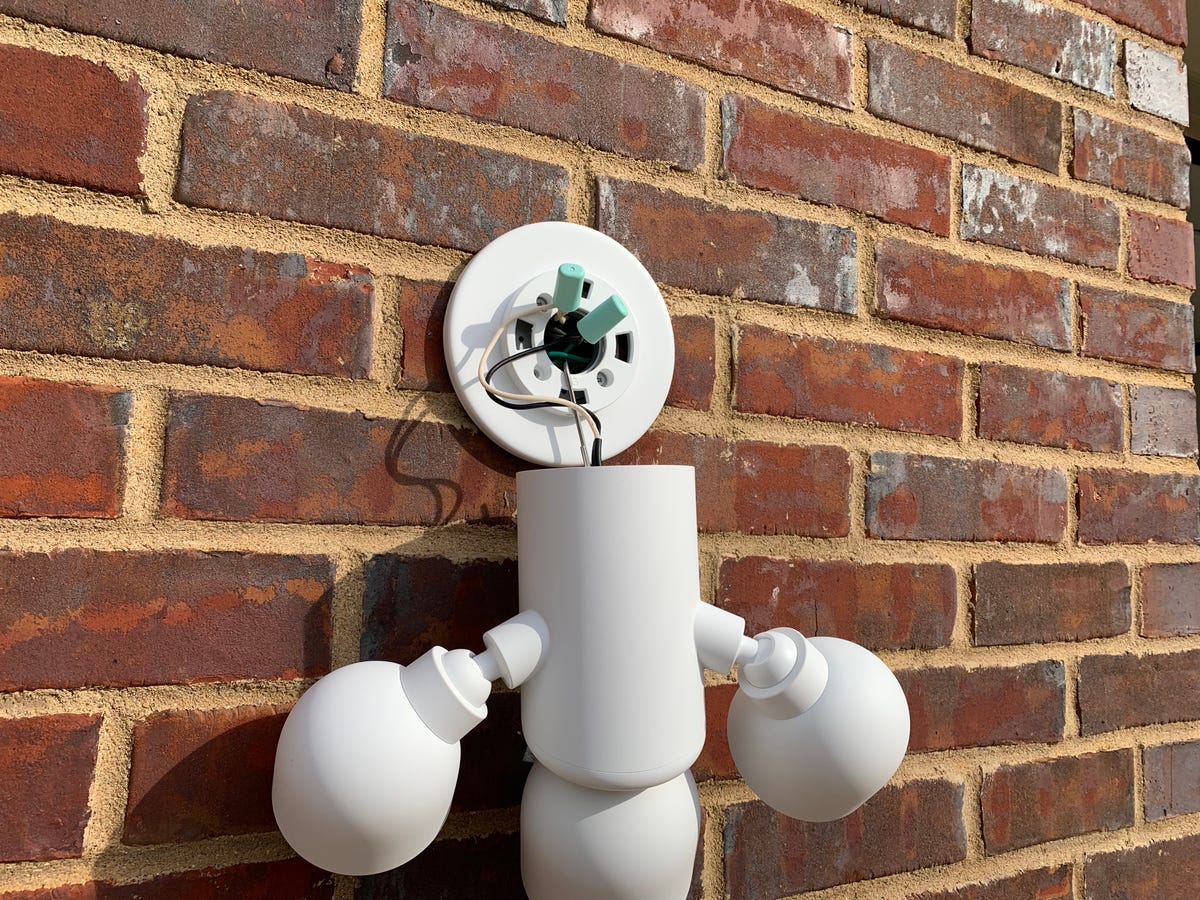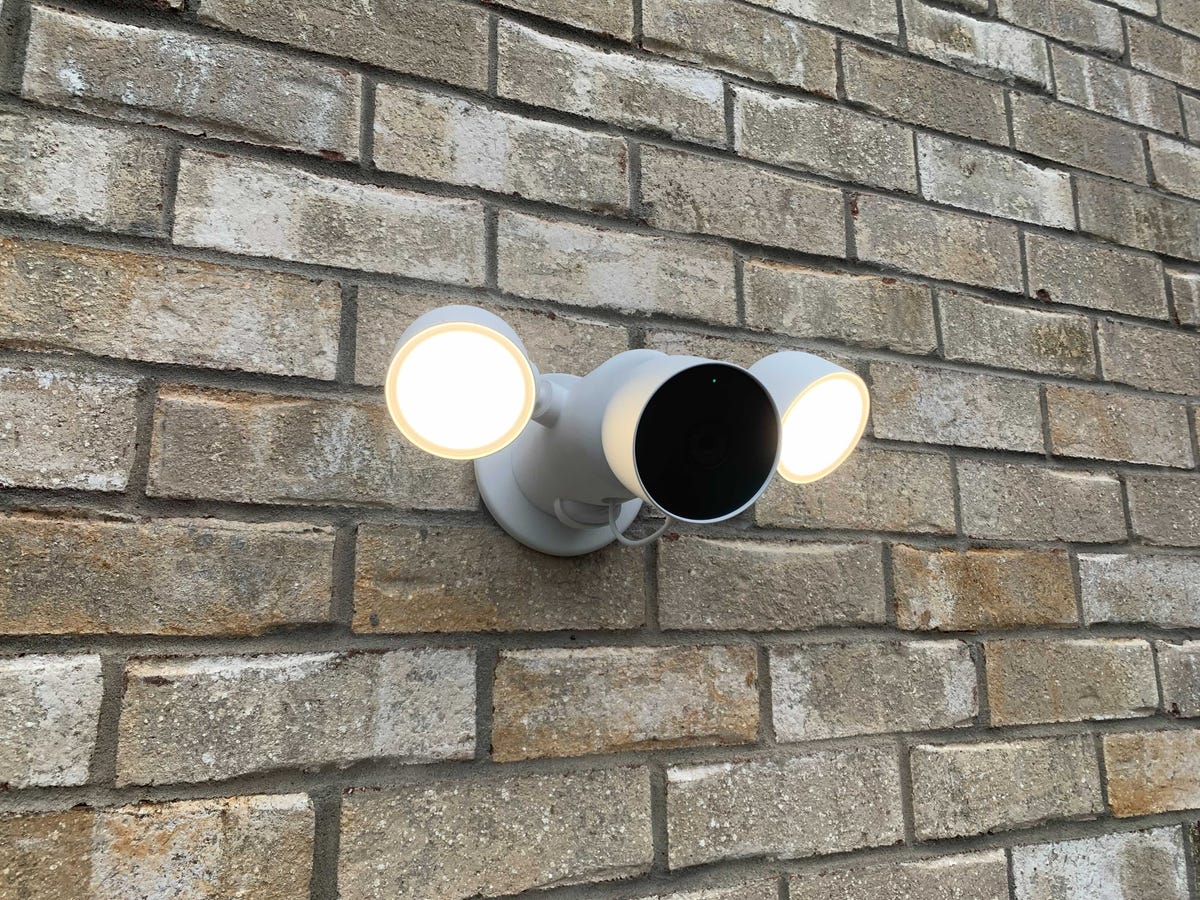Still one of the pricier floodlight cams in 2023
If you’re thinking about upgrading the security of your home’s exterior with a floodlight camera, you won’t find a product much better than the Nest Cam with Floodlight, even though it’s going on a couple years old now. Unfortunately, you may not find another floodlight camera that’s as expensive as this one is, either.
Like
- Bright lights
- Reliable performance
Don’t Like
- High price tag
- Inflexible installation options
- Slightly wonky device distinction in app
The setup is nice: You get two bright (2,400 lumens) lights attached to a Nest Cam with 1080p resolution and free event recording up to 3 hours. Installation can be a bit of a hassle (more on that below) and again, at $280, the Nest Cam with Floodlight comes at a higher price than similar products from Arlo, Ring and others.
Still, you may find the exceptionally bright lights and limited, but still free, cloud storage to justify the cost, especially if you’re partial to Nest products. Read our updated review, originally published Oct. 7, 2021, below to determine if the Nest Cam with Floodlight is worth the premium pricing.
Nest Cam with Floodlight review
Google’s approach to its Nest Cam with Floodlight is a lot like its competitors’: take an outdoor camera and slap some lights and a higher price tag on it. Ring’s done it; Arlo’s done it to even better effect. Even the super-affordable camera developer Wyze has gotten in on the action, offering a $10 spotlight that you can literally clip right onto an outdoor camera.
But as much as these cameras differ from one another in price, they also differ in features and overall quality. At $280, the wired-only Nest Cam with Floodlight is one of the most expensive options on the market, but it’s bright, smart and comes with a lot of perks for Google loyalists. Can it beat our favorite floodlight cam on the market? Let’s find out.
It’s a Nest Cam
OK, so if floodlight cams are basically just outdoor cameras with lights attached, the first question you should ask is, how good is the camera? Luckily, we’ve actually already reviewed the Nest Cam (battery) — which is almost identical in specifications to the base device here.
It’s a solid camera that performed admirably in our testing. The pros are clear: free smart alerts that distinguish between people, animals and vehicles; activity zones; on-device processing thanks to a new machine learning chip; and a great app experience. But the price — $180 up front and $6 per month for the optional-but-necessary-for-storage Nest Aware subscription — just doesn’t quite recommend the camera, especially against super-affordable competitors like Wyze and best-in-class competitors like Arlo.
One big difference between the Nest Cam (battery) and the Nest Cam with Floodlight is the wiring: as the name states, the Nest Cam (battery) doesn’t require fiddly wiring. The floodlight option, on the other hand, requires hardwiring to an outdoor fixture. If you don’t have one, you’re out of luck. And even if you do have one, installation isn’t going to be particularly breezy. Outdoor lights aren’t usually made to be easily removable, and permanently altering the exterior of your house is, well, undesirable for most people, to say the least.

The wire nuts included in the Nest Cam with Floodlight setup kit were too small for the wires in my exterior fixture. I had to remove them and replace them with others I had on hand.
David Priest/CNET
It took me a few hours to get the floodlight set up, and I consider myself fairly handy. The fixture I tried to replace first was old, and I discovered that the connection was faulty — whether that was because of the wiring itself (old circuits, amirite?) or the Nest Cam, I couldn’t figure out. When I did finally get the camera up and running, it required new, larger wire nuts (which I luckily had on hand) to fit the wires in my setup. I was disappointed the Nest Cam didn’t include various sizes for circumstances such as this.
The option to wire to an exterior outlet or use battery power, as you can with Arlo’s floodlight cam, would’ve been welcome alternatives to setup, too. As it is, you must have wiring for an exterior light — which most of the time is connected to an interior light switch that you’ll need to either remember to keep on or tape over to avoid cutting power to the camera.
Aside from the arduous installation process, Nest’s floodlight cam has two major distinctions from the Nest Cam (battery). The question is, how does the addition of two 2,400-lumen lights and the $100 price bump change the calculus? Well, not as much as you’d think — and probably not in the direction Google hopes.
First thought, Nest thought
This is Nest’s first floodlight camera, but it’s not the first on the market. Here’s how the Nest Cam with Floodlight lines up against its two biggest competitors: Amazon Ring and Arlo.
Nest vs. Ring vs. Arlo
| Nest Cam with Floodlight | Ring Floodlight Cam | Arlo Pro 3 with Floodlight | |
|---|---|---|---|
| Price | $280 | $180 | $250 |
| Resolution | 1080p | 1080p | 2k |
| Brightness | 2400 lumens | 1600 lumens | 2000 lumens (battery)/3000 lumens (wired) |
| Wiring | required | required | optional |
| Starting subscription fees | $6/month | $3/month | $3/month |
| Field of View | 130 degrees | 160 degrees | 160 degrees |
Nest fits comfortably in the range of its competitors — but it’s a little pricier both up-front and with monthly fees than both leading alternatives. It’s comparable in wiring setup and resolution to Ring’s much more affordable (and dimmer) floodlight camera, though the Ring device has a siren and Nest’s doesn’t. Nest falls between Ring and Arlo when it comes to floodlight brightness when wired (Arlo’s brightness is only 2000 lumens when operating on battery power).
Subscribe to Nest Aware for $6 per month and you’ll get familiar face detection and sound alerts (smoke alarm, glass breaking and carbon monoxide alarm), the ability to call 911 from the Google Home app and 30 days of event video history. Upgrade to Nest Aware Plus for $12 a month and you’ll get all of those options plus 60 days of video history and 10 days of 24/7 video recording.
In short, the Nest Cam with Floodlight isn’t outrageously priced — but it also doesn’t stand out as a particularly good deal for the features, especially when compared to the more affordable and equally well-featured competition.
How it drives
If you’ve ever bought a car off the lot, you probably know that the technical specs and aesthetic are often secondary to how it handles on the road. Well, Nest doesn’t disappoint here.
The Google Home app is easy to use and performs well. Pulling up the live feed takes a couple seconds, and the settings are fairly straightforward. You can dim the floodlight using a slider from 1% to 100%, and you can set the light to switch on according to preconditions, such as timers or motion alerts.

The Nest Cam’s floodlight is dimmable on the Google Home app — but not on the same screen as the live camera feed.
David Priest/CNET
It’s also easy to pull up your video history, sliding back to watch various events, which are labeled according to what prompted them — people, animals or vehicles. By and large, these settings work well. The one unintuitive bit is that the floodlight and the camera are treated as distinct devices in the app, meaning you can’t dim the light — or even turn it on — from the live stream of the camera. When you’re trying to find the right brightness setting, then, you have to toggle back and forth between the brightness slider and the live stream.
Despite this annoying quirk, I generally enjoyed exploring my new powers of remote observation in the Google Home app. Adding facial recognition with the Familiar Faces feature via Nest Aware has worked well for me, but I don’t think it’s a make-or-break feature. Instead, what you’ll probably want the subscription for is more storage than the three hours of event history.
I do appreciate the privacy aspects of the Nest Cam, too. Footage is encrypted while in transit from the camera and while at rest on Nest servers, and all the processing (like distinguishing between people, vehicles and animals, or processing face biometrics) will happen on the device itself — meaning that footage doesn’t need to be sent to the cloud other than for storage purposes.
Encrypting at these vulnerable in-transit and at-rest points in the chain helps prevent unauthorized access to your data from would-be hackers and spying eyes. While Ring offers more thorough end-to-end video encryption, it’s only on wired devices, and it’s something users have to opt into. Ring, of course, comes with its own set of privacy concerns.
The whole package
The Nest Cam with Floodlight is a solid device with great app control. The dual 2,400-lumen lights were bright enough to illuminate my back patio, and even give me pretty solid vision to the edge of my midsized yard at night, and the crisp 1080p image resolution and reliable smart alerts kept me apprised of all the activity going on in my backyard at any given time.
That said, I was disappointed to see such an inflexible setup process for what is designed to be a DIY device. More importantly, the pricing of both the camera and the subscription just doesn’t match the value of, say, Arlo’s $250 alternative, or Ring’s much more affordable floodlight cam.
For Google loyalists less concerned with value than brand consistency, perhaps the Nest Cam with Floodlight will scratch an untended itch. For the rest of us, there are better options, at better prices, on the market already.
Google Nest Cam With Floodlight Review: Good, but Expensive – CNET
Source: Media Star Philippines



0 Comments